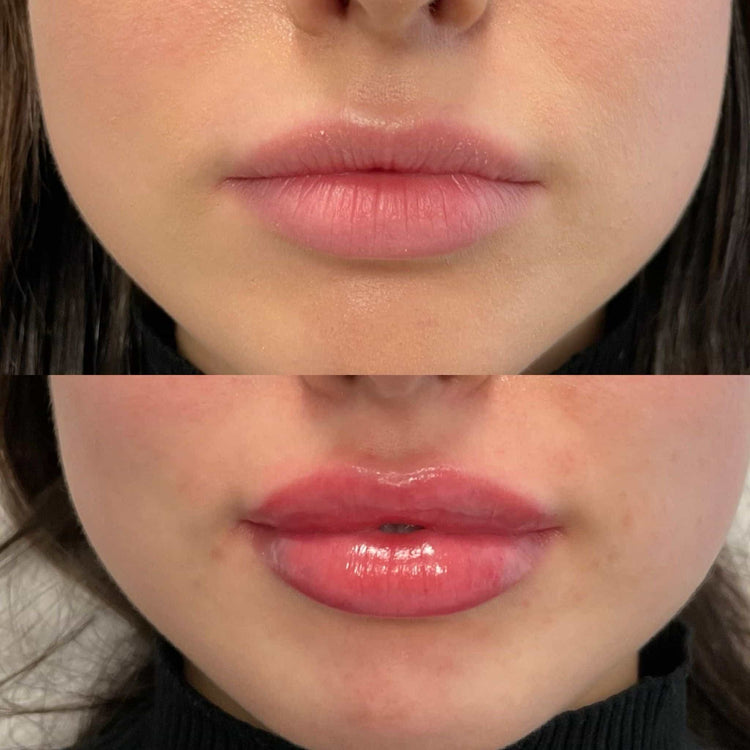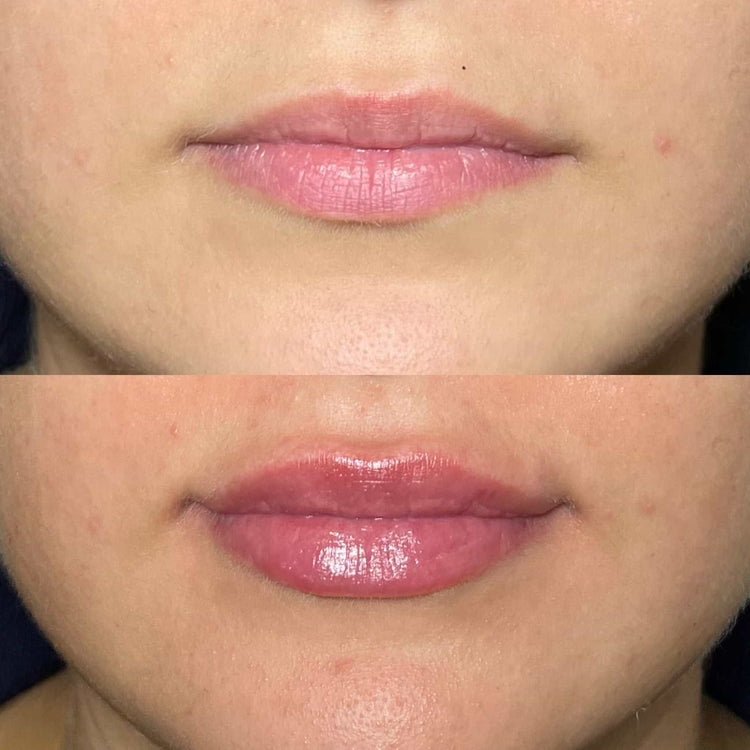Recognizing Poor Dermal Filler Results
Dermal fillers are becoming increasingly popular, offering a non-surgical way to enhance facial features and diminish signs of aging. However, achieving desirable results requires skilled practitioners and careful consideration. Understanding how to recognize potential issues with dermal filler placement can be crucial in addressing them effectively.
Asymmetry
Asymmetry is one of the most common concerns associated with poor dermal filler results. It occurs when one side of the face appears different from the other, often resulting in an uneven or disproportionate appearance. This asymmetry can manifest in various ways, such as: uneven cheek fullness, a drooping lip corner, or a misaligned jawline.
Recognizing asymmetry is important because it can significantly impact the overall aesthetic outcome of dermal filler treatment. If you notice any signs of asymmetry after a filler appointment, it’s crucial to consult with your practitioner promptly. They may be able to make adjustments or recommend additional treatments to restore balance and symmetry.
Lumps and Nodules
Lumps and nodules are another potential complication that can occur with dermal filler injections. These firm, raised areas under the skin often feel like small bumps and can arise from improper injection technique, overuse of filler material, or an allergic reaction. Lumps and nodules can detract from the smooth appearance desired after a filler treatment.
If you notice lumps or nodules following a dermal filler procedure, it is important to contact your practitioner immediately. They will assess the situation and determine the best course of action. Possible solutions may include massaging the area, applying topical medications, or using a specialized enzyme to dissolve the filler.
Over-filled Appearance
Dermal fillers are becoming increasingly popular, offering a non-surgical way to enhance facial features and diminish signs of aging. However, achieving desirable results requires skilled practitioners and careful consideration. Understanding how to recognize potential issues with dermal filler placement can be crucial in addressing them effectively.
- Asymmetry is one of the most common concerns associated with poor dermal filler results. It occurs when one side of the face appears different from the other, often resulting in an uneven or disproportionate appearance. This asymmetry can manifest in various ways, such as uneven cheek fullness, a drooping lip corner, or a misaligned jawline.
- Recognizing asymmetry is important because it can significantly impact the overall aesthetic outcome of dermal filler treatment. If you notice any signs of asymmetry after a filler appointment, it’s crucial to consult with your practitioner promptly. They may be able to make adjustments or recommend additional treatments to restore balance and symmetry.
- Lumps and nodules are another potential complication that can occur with dermal filler injections. These firm, raised areas under the skin often feel like small bumps and can arise from improper injection technique, overuse of filler material, or an allergic reaction. Lumps and nodules can detract from the smooth appearance desired after a filler treatment.
- If you notice lumps or nodules following a dermal filler procedure, it is important to contact your practitioner immediately. They will assess the situation and determine the best course of action. Possible solutions may include massaging the area, applying topical medications, or using a specialized enzyme to dissolve the filler.
unnatural contours
Unnatural contours can be a telltale sign of poor dermal filler results. These irregularities might manifest as overly pronounced features, unnatural angles, or a lack of smooth transitions between areas where filler was applied.
For example, excessively plump cheeks that appear disproportionate to the rest of the face, or lips that look too large or artificial, are examples of unnatural contours. It is essential to remember that dermal fillers should enhance natural features subtly, not drastically alter them.
Migration
Unnatural contours can be a telltale sign of poor dermal filler results. These irregularities might manifest as overly pronounced features, unnatural angles, or a lack of smooth transitions between areas where filler was applied.
For example, excessively plump cheeks that appear disproportionate to the rest of the face, or lips that look too large or artificial, are examples of unnatural contours. It is essential to remember that dermal fillers should enhance natural features subtly, not drastically alter them.
- Asymmetry is one of the most common concerns associated with poor dermal filler results. It occurs when one side of the face appears different from the other, often resulting in an uneven or disproportionate appearance. This asymmetry can manifest in various ways, such as uneven cheek fullness, a drooping lip corner, or a misaligned jawline.
- Recognizing asymmetry is important because it can significantly impact the overall aesthetic outcome of dermal filler treatment. If you notice any signs of asymmetry after a filler appointment, it’s crucial to consult with your practitioner promptly. They may be able to make adjustments or recommend additional treatments to restore balance and symmetry.
- Lumps and nodules are another potential complication that can occur with dermal filler injections. These firm, raised areas under the skin often feel like small bumps and can arise from improper injection technique, overuse of filler material, or an allergic reaction. Lumps and nodules can detract from the smooth appearance desired after a filler treatment.
- If you notice lumps or nodules following a dermal filler procedure, it is important to contact your practitioner immediately. They will assess the situation and determine the best course of action. Possible solutions may include massaging the area, applying topical medications, or using a specialized enzyme to dissolve the filler.
Migration occurs when the dermal filler material moves from its intended location to another area of the face. This can happen due to several factors, including improper injection technique, vigorous facial movements, or even the body’s natural breakdown and redistribution of filler over time.
Fixing Poor Dermal Filler Results
Dermal fillers offer a popular non-surgical approach to enhancing facial features and minimizing signs of aging. However, achieving desirable outcomes relies on skilled practitioners and careful consideration. Recognizing potential issues with dermal filler placement is crucial for effective resolution.
Dissolving the Filler
Fixing poor dermal filler results often involves addressing the specific issue present. Dissolving the filler is a viable option in certain situations.
Hyaluronic acid fillers, which are among the most common types of dermal fillers, can be dissolved using an enzyme called hyaluronidase. Hyaluronidase breaks down hyaluronic acid, allowing the filler to be gradually reabsorbed by the body.
If lumps or nodules form, or if asymmetry develops due to improper placement, hyaluronidase injections can help correct these issues.
It is essential to consult with a qualified medical professional experienced in dermal fillers for any concerns. They will assess the situation and determine the best course of action for dissolving the filler safely and effectively.
Hyaluronidase Injection
Dermal fillers offer a popular non-surgical approach to enhancing facial features and minimizing signs of aging. However, achieving desirable outcomes relies on skilled practitioners and careful consideration. Recognizing potential issues with dermal filler placement is crucial for effective resolution.
- Asymmetry is one of the most common concerns associated with poor dermal filler results. It occurs when one side of the face appears different from the other, often resulting in an uneven or disproportionate appearance. This asymmetry can manifest in various ways, such as uneven cheek fullness, a drooping lip corner, or a misaligned jawline.
- Recognizing asymmetry is important because it can significantly impact the overall aesthetic outcome of dermal filler treatment. If you notice any signs of asymmetry after a filler appointment, it’s crucial to consult with your practitioner promptly. They may be able to make adjustments or recommend additional treatments to restore balance and symmetry.
- Lumps and nodules are another potential complication that can occur with dermal filler injections. These firm, raised areas under the skin often feel like small bumps and can arise from improper injection technique, overuse of filler material, or an allergic reaction. Lumps and nodules can detract from the smooth appearance desired after a filler treatment.
- If you notice lumps or nodules following a dermal filler procedure, it is important to contact your practitioner immediately. They will assess the situation and determine the best course of action. Possible solutions may include massaging the area, applying topical medications, or using a specialized enzyme to dissolve the filler.
Unnatural contours can be a telltale sign of poor dermal filler results. These irregularities might manifest as overly pronounced features, unnatural angles, or a lack of smooth transitions between areas where filler was applied.
For example, excessively plump cheeks that appear disproportionate to the rest of the face, or lips that look too large or artificial, are examples of unnatural contours. It is essential to remember that dermal fillers should enhance natural features subtly, not drastically alter them.
Migration occurs when the dermal filler material moves from its intended location to another area of the face. This can happen due to several factors, including improper injection technique, vigorous facial movements, or even the body’s natural breakdown and redistribution of filler over time.
Fixing poor dermal filler results often involves addressing the specific issue present. Dissolving the filler is a viable option in certain situations.

Hyaluronic acid fillers, which are among the most common types of dermal fillers, can be dissolved using an enzyme called hyaluronidase. Hyaluronidase breaks down hyaluronic acid, allowing the filler to be gradually reabsorbed by the body.
If lumps or nodules form, or if asymmetry develops due to improper placement, hyaluronidase injections can help correct these issues.
It is essential to consult with a qualified medical professional experienced in dermal fillers for any concerns. They will assess the situation and determine the best course of action for dissolving the filler safely and effectively.
Revision Placement of Filler
Dermal fillers offer a popular non-surgical approach to enhancing facial features and minimizing signs of aging. However, achieving desirable outcomes relies on skilled practitioners and careful consideration. Recognizing potential issues with dermal filler placement is crucial for effective resolution.

Asymmetry is one of the most common concerns associated with poor dermal filler results. It occurs when one side of the face appears different from the other, often resulting in an uneven or disproportionate appearance. This asymmetry can manifest in various ways, such as uneven cheek fullness, a drooping lip corner, or a misaligned jawline.
Recognizing asymmetry is important because it can significantly impact the overall aesthetic outcome of dermal filler treatment. If you notice any signs of asymmetry after a filler appointment, it’s crucial to consult with your practitioner promptly. They may be able to make adjustments or recommend additional treatments to restore balance and symmetry.
Lumps and nodules are another potential complication that can occur with dermal filler injections. These firm, raised areas under the skin often feel like small bumps and can arise from improper injection technique, overuse of filler material, or an allergic reaction. Lumps and nodules can detract from the smooth appearance desired after a filler treatment.
If you notice lumps or nodules following a dermal filler procedure, it is important to contact your practitioner immediately. They will assess the situation and determine the best course of action. Possible solutions may include massaging the area, applying topical medications, or using a specialized enzyme to dissolve the filler.
Unnatural contours can be a telltale sign of poor dermal filler results. These irregularities might manifest as overly pronounced features, unnatural angles, or a lack of smooth transitions between areas where filler was applied.
For example, excessively plump cheeks that appear disproportionate to the rest of the face, or lips that look too large or artificial, are examples of unnatural contours. It is essential to remember that dermal fillers should enhance natural features subtly, not drastically alter them.
Migration occurs when the dermal filler material moves from its intended location to another area of the face. This can happen due to several factors, including improper injection technique, vigorous facial movements, or even the body’s natural breakdown and redistribution of filler over time.
Fixing poor dermal filler results often involves addressing the specific issue present. Dissolving the filler is a viable option in certain situations.
Hyaluronic acid fillers, which are among the most common types of dermal fillers, can be dissolved using an enzyme called hyaluronidase. Hyaluronidase breaks down hyaluronic acid, allowing the filler to be gradually reabsorbed by the body.
If lumps or nodules form, or if asymmetry develops due to improper placement, hyaluronidase injections can help correct these issues.

It is essential to consult with a qualified medical professional experienced in dermal fillers for any concerns. They will assess the situation and determine the best course of action for dissolving the filler safely and effectively.
Strategic Redistribution
Dermal fillers are becoming increasingly popular, offering a non-surgical way to enhance facial features and diminish signs of aging. However, achieving desirable results requires skilled practitioners and careful consideration. Understanding how to recognize potential issues with dermal filler placement can be crucial in addressing them effectively.
- Asymmetry is one of the most common concerns associated with poor dermal filler results. It occurs when one side of the face appears different from the other, often resulting in an uneven or disproportionate appearance. This asymmetry can manifest in various ways, such as: uneven cheek fullness, a drooping lip corner, or a misaligned jawline.
- Recognizing asymmetry is important because it can significantly impact the overall aesthetic outcome of dermal filler treatment. If you notice any signs of asymmetry after a filler appointment, it’s crucial to consult with your practitioner promptly. They may be able to make adjustments or recommend additional treatments to restore balance and symmetry.
- Lumps and nodules are another potential complication that can occur with dermal filler injections. These firm, raised areas under the skin often feel like small bumps and can arise from improper injection technique, overuse of filler material, or an allergic reaction. Lumps and nodules can detract from the smooth appearance desired after a filler treatment.
- If you notice lumps or nodules following a dermal filler procedure, it is important to contact your practitioner immediately. They will assess the situation and determine the best course of action. Possible solutions may include massaging the area, applying topical medications, or using a specialized enzyme to dissolve the filler.
Unnatural contours can be a telltale sign of poor dermal filler results. These irregularities might manifest as overly pronounced features, unnatural angles, or a lack of smooth transitions between areas where filler was applied.
For example, excessively plump cheeks that appear disproportionate to the rest of the face, or lips that look too large or artificial, are examples of unnatural contours. It is essential to remember that dermal fillers should enhance natural features subtly, not drastically alter them.
Migration occurs when the dermal filler material moves from its intended location to another area of the face. This can happen due to several factors, including improper injection technique, vigorous facial movements, or even the body’s natural breakdown and redistribution of filler over time.
Fixing poor dermal filler results often involves addressing the specific issue present. Dissolving the filler is a viable option in certain situations.
Hyaluronic acid fillers, which are among the most common types of dermal fillers, can be dissolved using an enzyme called hyaluronidase. Hyaluronidase breaks down hyaluronic acid, allowing the filler to be gradually reabsorbed by the body.
If lumps or nodules form, or if asymmetry develops due to improper placement, hyaluronidase injections can help correct these issues.
It is essential to consult with a qualified medical professional experienced in dermal fillers for any concerns. They will assess the situation and determine the best course of action for dissolving the filler safely and effectively.
Learn more about wrinkle-smoothing dermal fillers with Dr. Laura Geige at It’s Me & You Clinic
